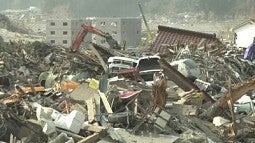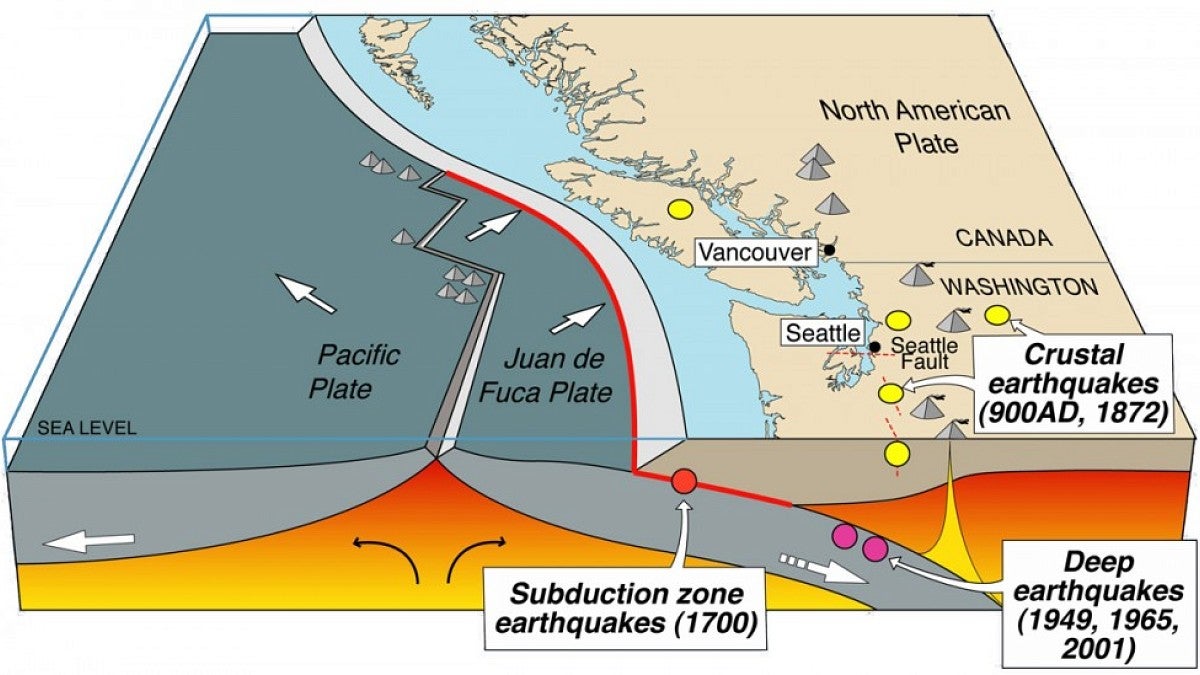
Worried about the potential Cascadia earthquake scenario described in recent New Yorker articles?
Those articles, according to University of Oregon geologists Rebecca Dorsey and Douglas Toomey, provide for a timely, teachable moment about recent advances toward regional preparedness and efforts to expand a West Coast earthquake early warning system.
WATCH the recorded presentation
To address these topics, a public forum, "The Really Big One," will be held from 7 to 9 p.m. Thursday, Aug. 6, on the UO campus. The event will be held in Room 156 of Straub Hall, 1451 Onyx St., located just southeast of the Erb Memorial Union. Seating capacity is 520. Admission is free. Registration is not required.
The forum is being designed to clarify, by way of the science, likely scenarios for a major regional earthquake. It will be streamed live on the web via the UO Channel. A second location, Room 145 of Straub Hall, also will be available for an additional 140 people who can watch the session via the live stream.
Three short presentations will focus on the types of earthquakes that occur in the Pacific Northwest, the history of the Cascadia subduction zone and what people, especially in the Eugene-Springfield area, might experience in an earthquake registering at magnitude 9 or above.
Also coming: Faculty-Staff Earthquake Emergency Management Session
The UO Department of Geological Sciences and Emergency Management & Continuity are offering a one-hour "earthquake preparedness" training to interested faculty and staff members of the UO. The course is offered at 1 p.m. Friday, Aug. 7, and at 10:30 a.m. Friday, Aug. 14. (Update: Aug. 7 class is full; very few seats remain for Aug. 14.)
Participants will learn how to prepare their families and homes for an earthquake. Straub Hall 156. Enrollment is limited. Registration required.
"In addition to the magazine's story," said Dorsey, head of the Department of Geological Sciences, "there have been a number of books written recently on the importance of the challenges we may face in a major earthquake. People need to understand what's going to happen, and that there will be challenges."
The forum will feature a five-member scientific panel of experts. On the panel will be Toomey, Amanda Thomas and Ray Weldon of the UO's Department of Geological Sciences, which has a long history of field research related to earthquakes and volcanic activity in the Pacific Northwest.
Thomas, new to the UO, has an active research program in seismology. Weldon is known for his work on the science behind national seismic hazard maps that are used by the insurance industry in developing risk assessments and insurance rates. Toomey heads Oregon's role in the Pacific Northwest Seismic Network, which is working to expand a network of monitoring stations, especially in Oregon, that would help provide critical advanced notifications to communities as part of the West Coast earthquake early warning system.
Also on the panel will be Chris Goldfinger, a professor in Oregon State University's College of Earth, Ocean, and Atmospheric Sciences, and Josh Bruce of the UO-based Oregon Partnership for Disaster Resilience, an applied research program that provides technical assistance to help communities prepare and recover from disasters.
Toomey, Goldfinger and Bruce will deliver the brief talks, after which the forum will be open to questions from the public. All members of the panel will provide answers.
Toomey will address the hazards posed by a strong Cascadia earthquake and efforts to enhance an earthquake early warning system.
Goldfinger's research has been pivotal in determining the probabilities involved in regional earthquake forecasting. He has studied offshore sand deposits that record some 10,000 years of earthquakes in the Cascadia subduction zone. The zone, or fault line, stretches along the juncture of the Juan de Fuca and North America plates from Mendocino, California, to Vancouver, British Columbia.
Bruce will address ongoing efforts to mitigate the risks of a major earthquake, how to prepare and what initial steps would be necessary for an effective recovery.
— By Jim Barlow, Public Affairs Communications


